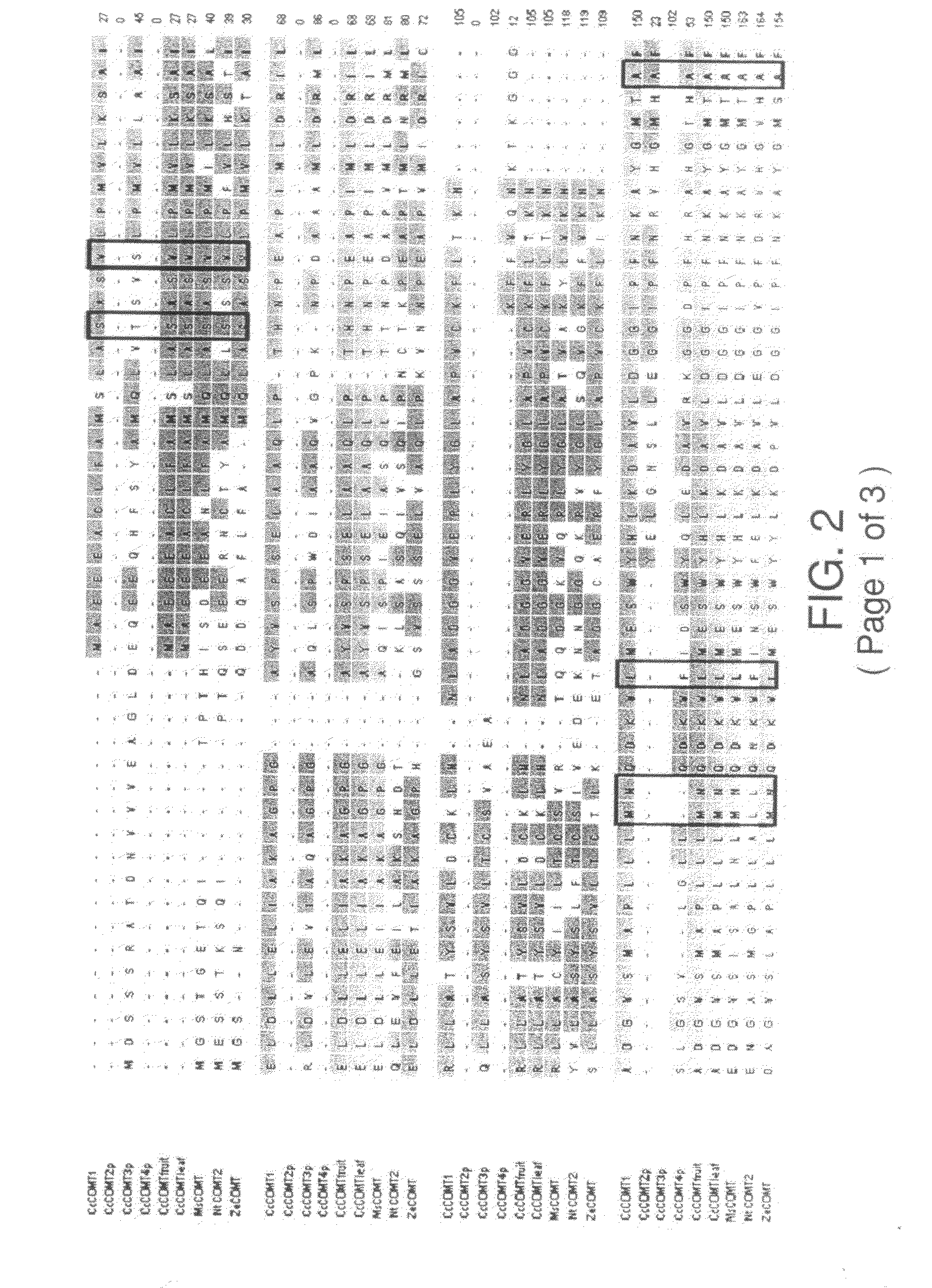Polynucleotides Encoding Lignin Biosynthetic Pathway Enzymes in Coffee
a technology of lignin biosynthetic pathway and polynucleotide, which is applied in the field of agricultural biotechnology, can solve the problems of poor yield, low information concerning the influence of natural coffee grain components such as polysaccharides, proteins, pigments, lipids, etc., and achieve the effects of modulating the flavor or aroma of coffee beans, increasing the expression of one or more endogenous lignin, and increasing the production of one or more lignin
- Summary
- Abstract
- Description
- Claims
- Application Information
AI Technical Summary
Benefits of technology
Problems solved by technology
Method used
Image
Examples
example 1
Materials and Methods for Subsequent Examples
[0107]A genomic strategy was chosen as a first approach towards understanding lignin synthesis in coffee. This strategy was based on the recently completed Nestlé / Cornell EST (Expressed Sequence Tags) library which contains 46,914 high quality EST sequences. These sequences have been assembled in-silico into 13,175 unique DNA sequences (unigenes) representing C. canephora genes being expressed in young leaves, in developing pericarp tissues (all stages mixed), and in developing grain at several distinct stages.
[0108]The unigene set of the Nestlé / Cornell database was searched using the tblastn algorithm (Altschul et al. 1990) for coffee sequences encoding full or partial ORF's (open reading frame) for polypeptides that code for caffeic acid O-methyltransferases, cinnamoyl CoA reductases, cinnamyl alcohol dehydrogenases, and ferulate-5-hydroxylases exhibiting high similarity to biochemically characterized plant proteins present in the NCBI ...
example 2
Isolation and Characterization of Coffea cDNA Clones Encoding Caffeic Acid O-Methyltransferase (COMT)
[0110]To find cDNA encoding coffee caffeic acid O-methyltranferase, the protein sequences of biochemically-characterized COMT proteins from Medicago sativa COMT (GenBank Accession Number AAB46623 (SEQ ID NO: 31), Gowri et al. 1991) and of Zinnia elegans COMT (GenBank Accession Number Q43239 (SEQ ID NO: 33), Ye et al. 1995) were used as the query sequences for a BLAST search against the Nestlé / Cornell “unigene” set 5 using the tblastn algorithm. The first search with the M. sativa COMT protein sequence uncovered 8 unigenes: #123802 (e value=e-165), #131937 (e value=1e-72), #120178 (e value=2e-63), #128376 (e value=1e-55), #120387 (e value=1e-35), #128163 (e value=2e-28), #127201 (e value=5e-24), and #120390 (e value=1e-23). These unigenes exhibited relatively high levels of homology. The second search with COMT from Zinnia elegans (SEQ ID NO: 33) uncovered the same 8 unigenes: #123802...
example 3
Isolation and Characterization of a Coffea canephora cDNA Clone Encoding Cinnamoyl CoA Reductase (CCR)
[0123]To find cDNA encoding coffee Cinnamoyl CoA Reductase, the protein sequences of biochemically-characterized CCR proteins Eucalyptus gunnii CCR (GenBank Accession Number T10735 (SEQ ID NO: 34), Lacombe et al. 1997) and of Triticum aestivum CCR (GenBank Accession Number AAX08107 (SEQ ID NO: 35), Ma et al. 2005) were used as the query sequences for a BLAST search against the Nestlé / Cornell “unigene” set 5 using the tblastn algorithm. The first search with the E. gunnii CCR protein sequence uncovered 1 unigenes #129581 (e value=e-121) exhibiting relatively high levels of homology. The second search with COMT from Zinnia elegans uncovered the same unigene #129581 (e value=9e-83).
[0124]Coffea canephora CeCCR1 (full ORF). The clone A5-1232, which is highly related to Cinnamoyl CoA Reductase from E. gunnii and T. aestivum (GenBank Accession Number respectively T10735 and AAX08107) (SEQ...
PUM
| Property | Measurement | Unit |
|---|---|---|
| nucleic acid | aaaaa | aaaaa |
| resistance | aaaaa | aaaaa |
| chemical | aaaaa | aaaaa |
Abstract
Description
Claims
Application Information
 Login to View More
Login to View More - R&D
- Intellectual Property
- Life Sciences
- Materials
- Tech Scout
- Unparalleled Data Quality
- Higher Quality Content
- 60% Fewer Hallucinations
Browse by: Latest US Patents, China's latest patents, Technical Efficacy Thesaurus, Application Domain, Technology Topic, Popular Technical Reports.
© 2025 PatSnap. All rights reserved.Legal|Privacy policy|Modern Slavery Act Transparency Statement|Sitemap|About US| Contact US: help@patsnap.com



